Two-tone kitchen cabinets are quickly rising in popularity for their ability to add visual interest and dimension to any kitchen design. By combining two complementary colors on the upper and lower cabinets, this stylish trend creates appealing contrast and allows homeowners to make a dramatic statement. Beyond just aesthetics, the two-tone look also offers smart functionality. The varying cabinet colors can help ground lower cabinets to create the illusion of more space, while drawing the eye upward with lighter upper cabinets to make small kitchens appear larger and more open. With so many potential color combinations, two-tone kitchens can fit any style, from classic to contemporary. This guide will explore the many benefits of mixing and matching cabinet colors and provide color pairing ideas, design tips, and practical guidance on implementing this hot trend. Let’s dive into the creative possibilities of two-tone kitchen cabinets!

The mix-and-match, eclectic nature of two-tone kitchen cabinets adds visual interest to what is often the largest feature in a kitchen – the cabinetry. By breaking up the monotony of uniform cabinets, this fresh take on kitchen design adds dimension and gives the eyes a place to rest. The right color combination can make a bold statement or create a soothing oasis, completely transforming the ambiance of the space. Beyond just aesthetics, the strategic use of color in two-tone kitchens can also create the perception of a larger, more spacious room.
Visual Dynamics of Two-Tone Cabinets
One of the biggest draws of the two-tone kitchen cabinet trend is the striking visual impact it makes. By breaking up the monotony of a single cabinet color, it adds dimension, contrast, and flair to kitchen spaces in several key ways:
Creates Visual Interest
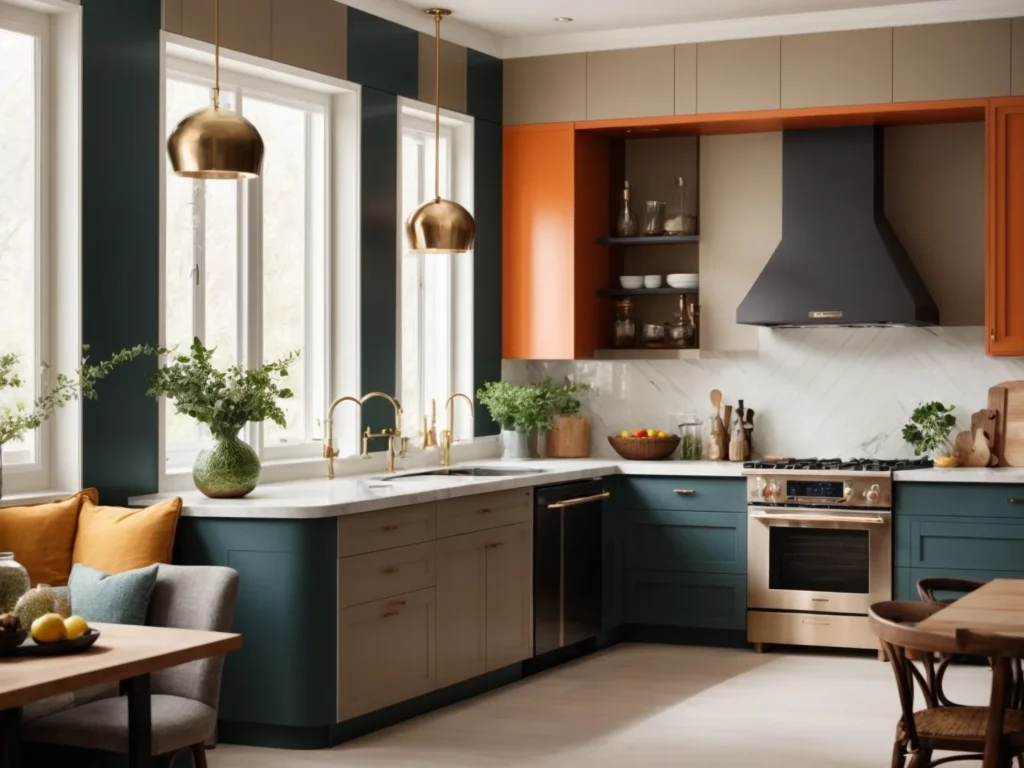
Having an upper and lower cabinet color immediately draws the eye to the contrast. The juxtaposition of two tones is inherently more visually interesting than a single tone look. Light and dark, matte and glossy, neutral and saturated – there are so many ways to create compelling color combinations. This makes the kitchen cabinetry a focal point and key design feature rather than fading into the background.
Adds Dimension

Choosing two colors strategically can add the illusion of dimension to kitchen spaces. Lighter upper cabinets lift and brighten, darker lower cabinets ground and anchor, creating more depth visually. Cool and warm tones can also push and pull space as well. This extra dimension makes kitchens feel more dynamic and inviting.
Breaks Up Monotony
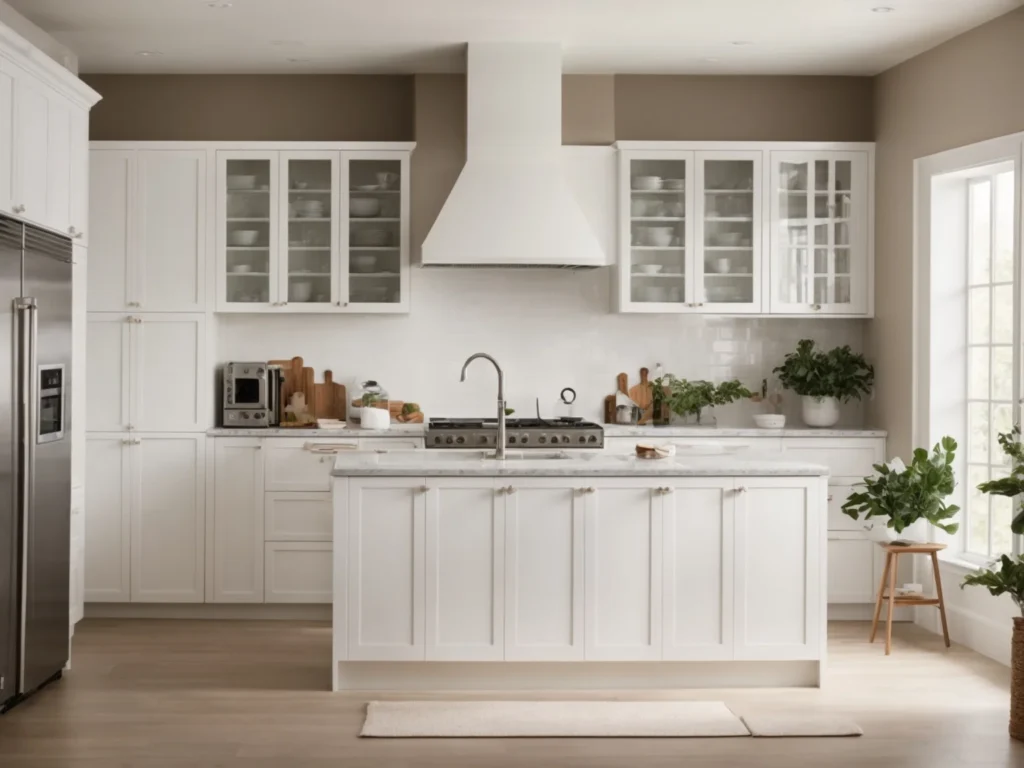
For many years, all-white kitchens have been popular for their clean, classic look. However, all-white cabinetry can start to feel monotonous or clinical over time. Two-tone cabinets offer the best of both worlds – keeping the timeless appeal of white while adding a modern, bold twist. It allows more customization too.
Provides Stylish Contrast
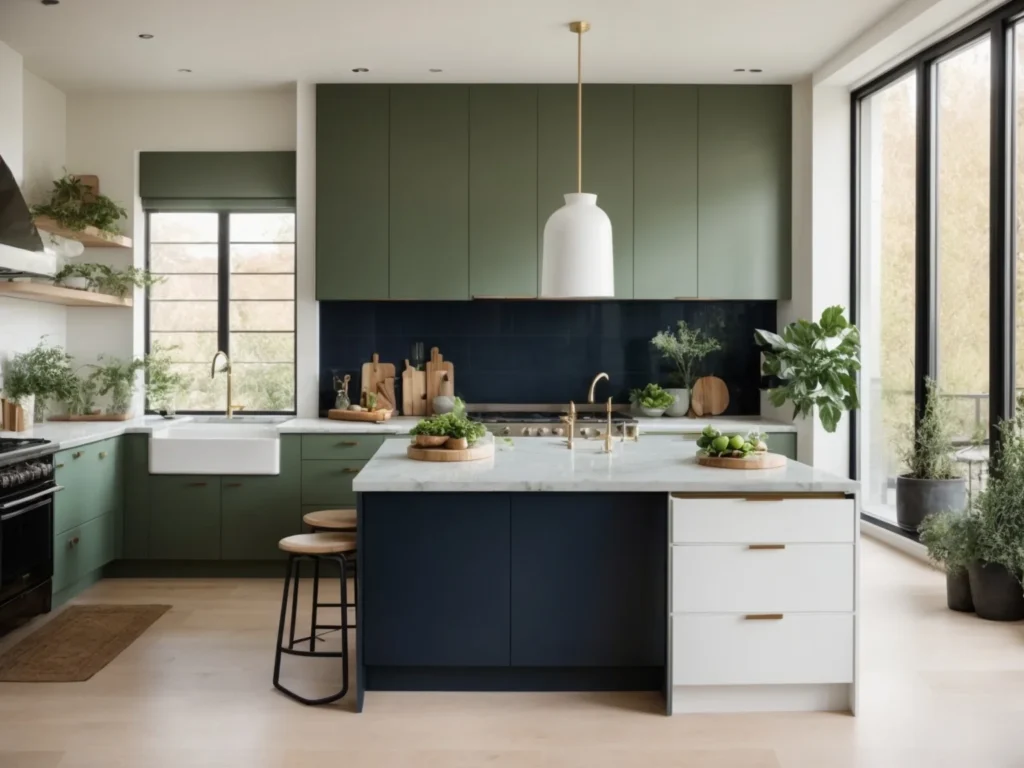
More than just using two random cabinet colors, two-tone kitchens look best when the upper and lower tones are thoughtfully contrasted. Crisp white uppers look striking against bold navy lowers. Vintage-inspired sage green lowers look lively against sleek white uppers. The juxtaposition of contrasting shades is what gives this trend its stylistic edge.
Modernizes Neutral Spaces
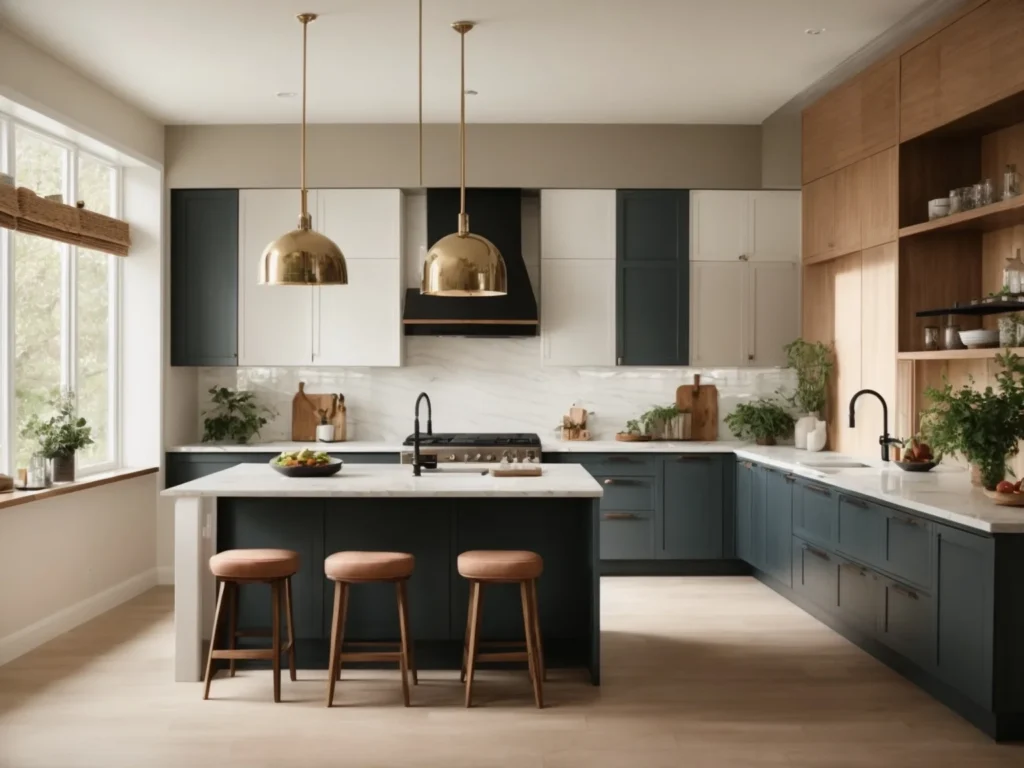
For homeowners that prefer softer, neutral palettes, two-tone cabinets can inject just the right amount of modern flair without overwhelming the space. Keeping one tone neutral while selecting a bold accent color for the other cabinets prevents the kitchen from feeling too monotonous.
Pops in Colorful Kitchens
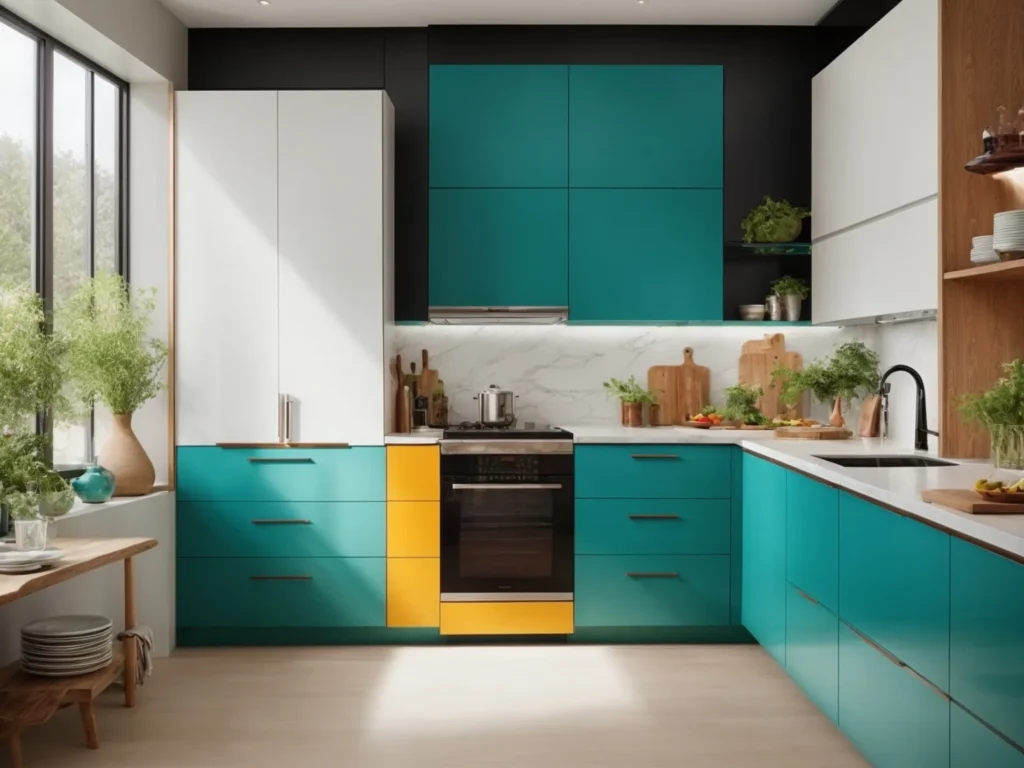
In already colorful kitchens, two-tone cabinets can provide just the right amount of additional contrast and interest. For example, pairing vibrant turquoise lowers with crisp white uppers allows the colorful cabinets to pop even more.
Focal Point of Any Kitchen
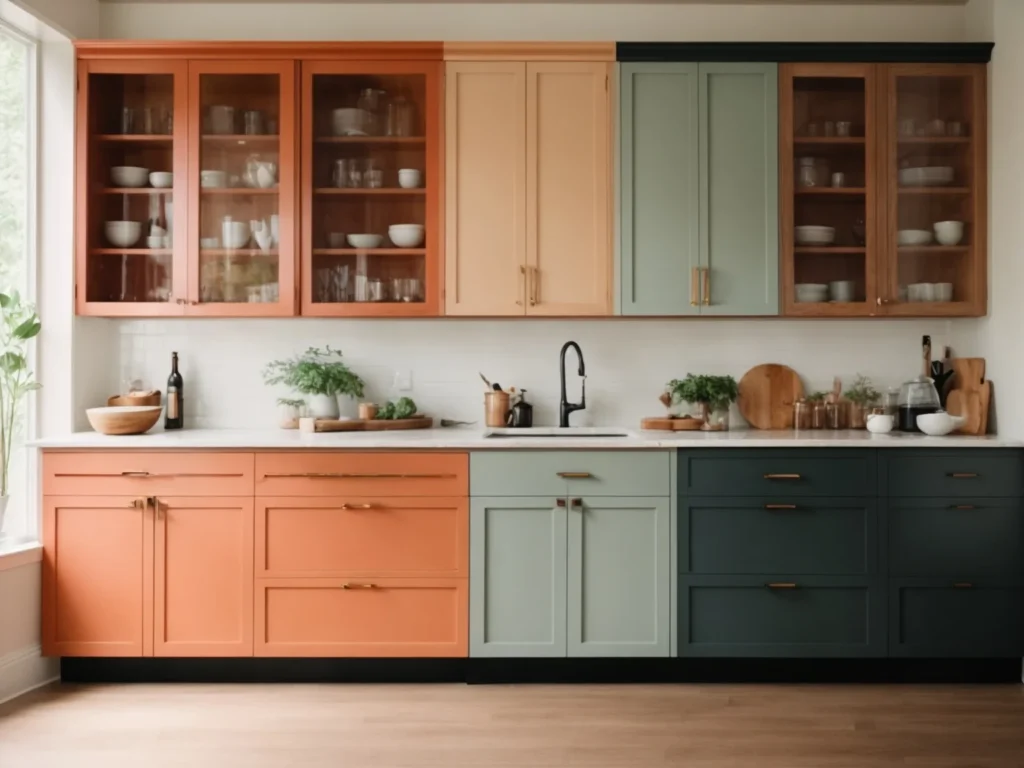
With so much visual interest, contrast, and flair, two-tone cabinets truly become a focal point in both vintage-inspired and ultra-modern kitchens. The eye is immediately drawn to the duo of colors, making the cabinetry a centerpiece of the whole kitchen design.
Perception of Space
In addition to amping up kitchen style, two-tone cabinets can also manipulate perceptions of space in several illusory ways when the tones are strategically selected.
Expands Small Kitchens

Choosing lighter upper cabinets coupled with deeper, grounded lower cabinets makes small kitchen spaces appear larger and more open. The light cabinets lift and brighten the room, while the dark cabinets appear to recede back, expanding boundaries.
Airy and Open Feeling

Specifically, lighter upper cabinets draw the eyes upwards and make kitchens feel taller. This also contributes to a more open, airy aesthetic. Crisp white upper cabinets contrasted against navy lowers are a popular combination for creating this effect.
Cozy and Grounded

Alternatively, darker upper cabinets feel cozy and cocooning when paired with lighter lowers. For farmhouse or traditional spaces, this helps kitchens feel more grounded and welcoming. Soft cream lower cabinets contrast nicely with rich espresso uppers for a cozy appeal.
Warm and Cool Tones

Warm cabinet colors like reds, yellows, and oranges tend to come forward visually while cool blues, grays, greens seem to recede. Keeping this color psychology in mind allows even more manipulation of kitchen proportions. Warm upper cabinets make the room feel smaller and cozier, cool upper cabinets make it feel more expansive.
Strategic Color Placement
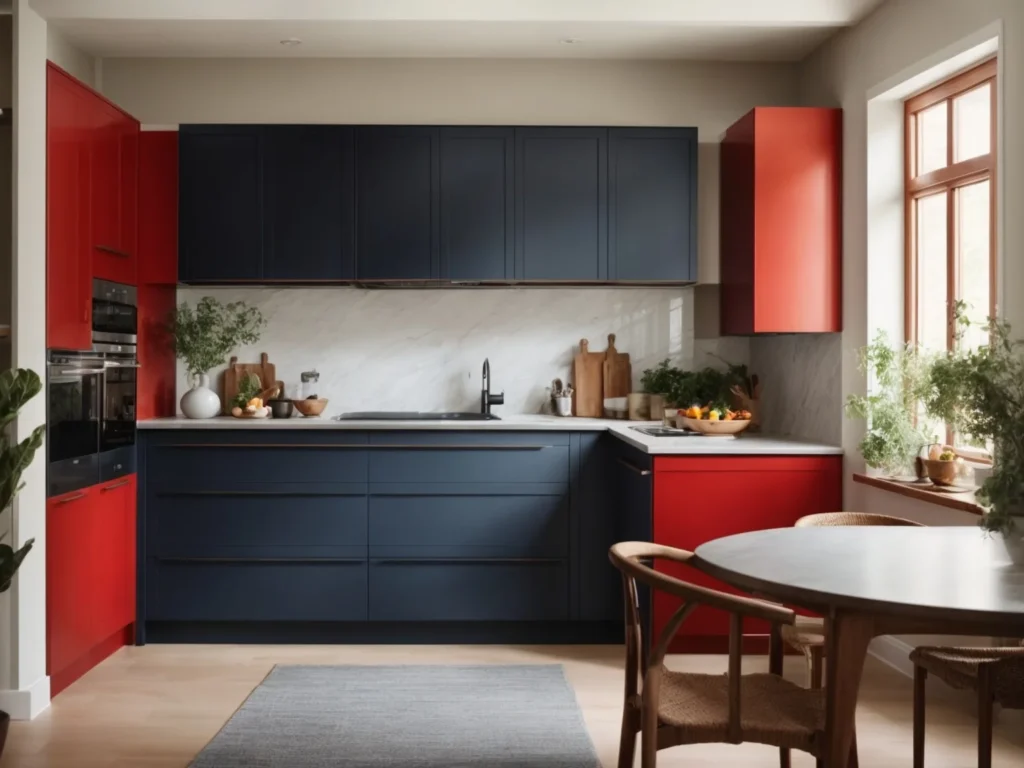
No matter the size of the kitchen, the placement of the lighter or darker tone, warm or cool tone can strategically expand or contract the feeling of space. A navy on bottom, blue-gray on top opens up a small kitchen. Red on bottom, neutral up top makes a large kitchen feel cozier. The colors and placement can create an optical effect to fit any spatial needs.
Adds Storage Optically
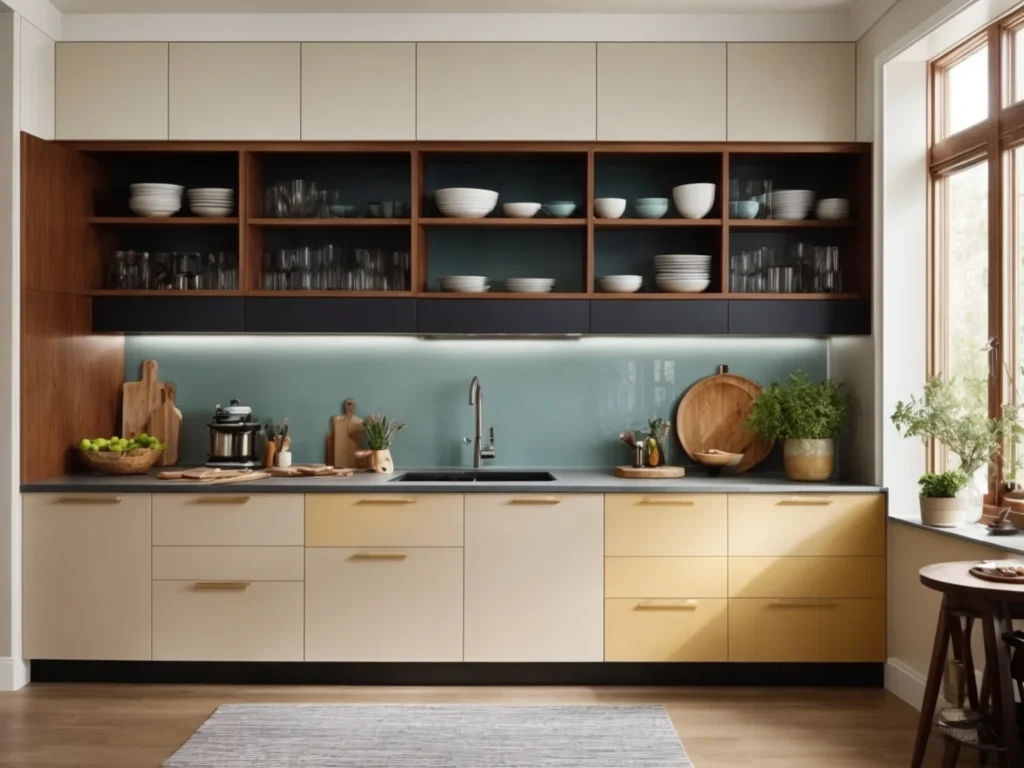
In addition to playing with proportions, two-toned cabinets can also create the illusion of more storage. Light open shelving or glass cabinet doors paired with deep lower cabinets make kitchen items seem more hidden away and plentiful. The eye focuses on the large swaths of color rather than picking out every item.
Best Practices for Two-Tone Kitchen Cabinets
While two tones can look amazing in any kitchen, following some best practices will ensure the look is cohesive, polished, and aesthetically pleasing:
Contrast the Tones
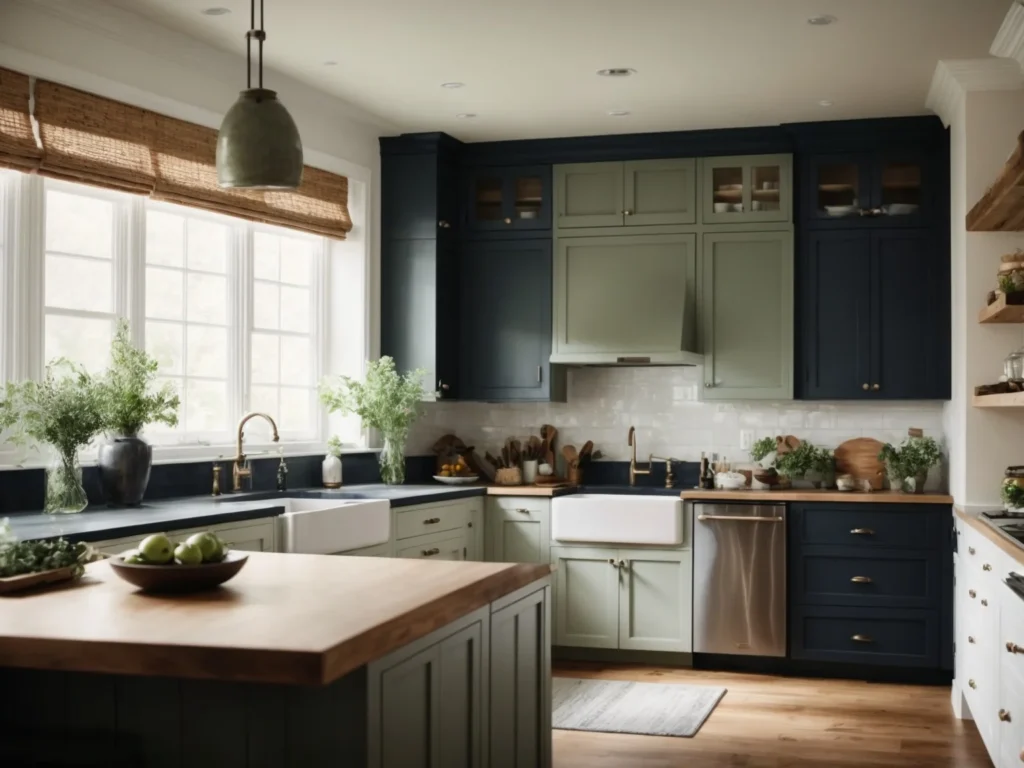
As mentioned, contrast is key for two-tone cabinets to have maximum visual impact. Crisp white and navy, antique white and charcoal, natural wood and sage green—contrasting textures and depths between the two colors makes the biggest style statement.
Comforting Combinations

That being said, clashing colors can feel disjointed or messy. Stick to palette combinations that make sense to the eye – lighter above, darker below or vibrant below, neutral above. Monochromatic contrasts like navy and baby blue also look sophisticated.
Complementary Colors
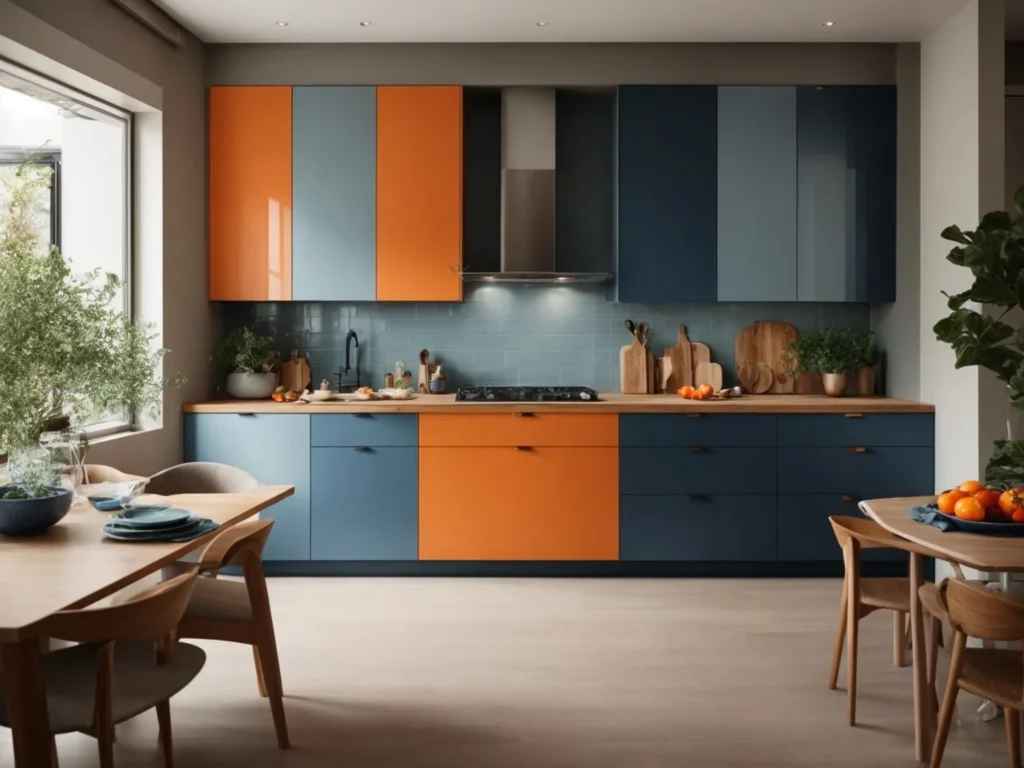
Choose two tones that live harmoniously together on the color wheel for a pulled-together look. Blue and orange, green and red, yellow and violet are pairings that complement. For neutrals, layering warm and cool grays creates a soothing, dimensional neutral palette.
Consistent Undertones

When selecting two colors, keeping the undertones consistent creates flow. For example, pairing two cool-toned cabinets (say, gray and blue) or two warm wood tones (cherry and walnut) ties the look together. Mixing undertones can feel disjointed.
Glossy Up, Matte Down

Having glossy or glass-front uppers adds depth, while matte, solid lower cabinets ground the space. The mix of finishes also adds stylish contrast and visual appeal. Just avoid glossy lower cabinets which can appear cheap or overwhelming.
Saturated Below, Neutral Above
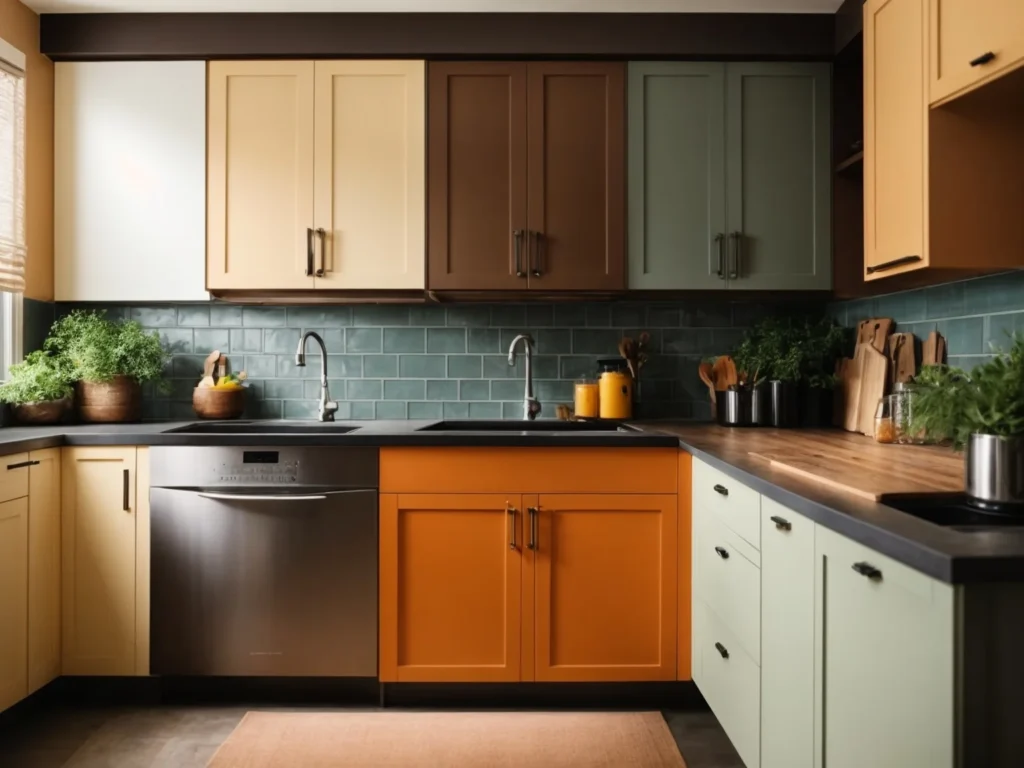
In most cases, saturated or bold color on lower cabinets balanced with neutral, lighter uppers creates the most pleasing aesthetic. Reverse this formula with caution – neutral lowers and bold uppers can feel top heavy, dark, and overwhelming very quickly.
Consistent Level of Contrast

The degree of contrast between the two cabinets should be consistent from set to set for continuity. Don’t pair navy and white in one area then do charcoal and sage in another. Keeping the overall level of contrast consistent creates flow.
Lighting Differences
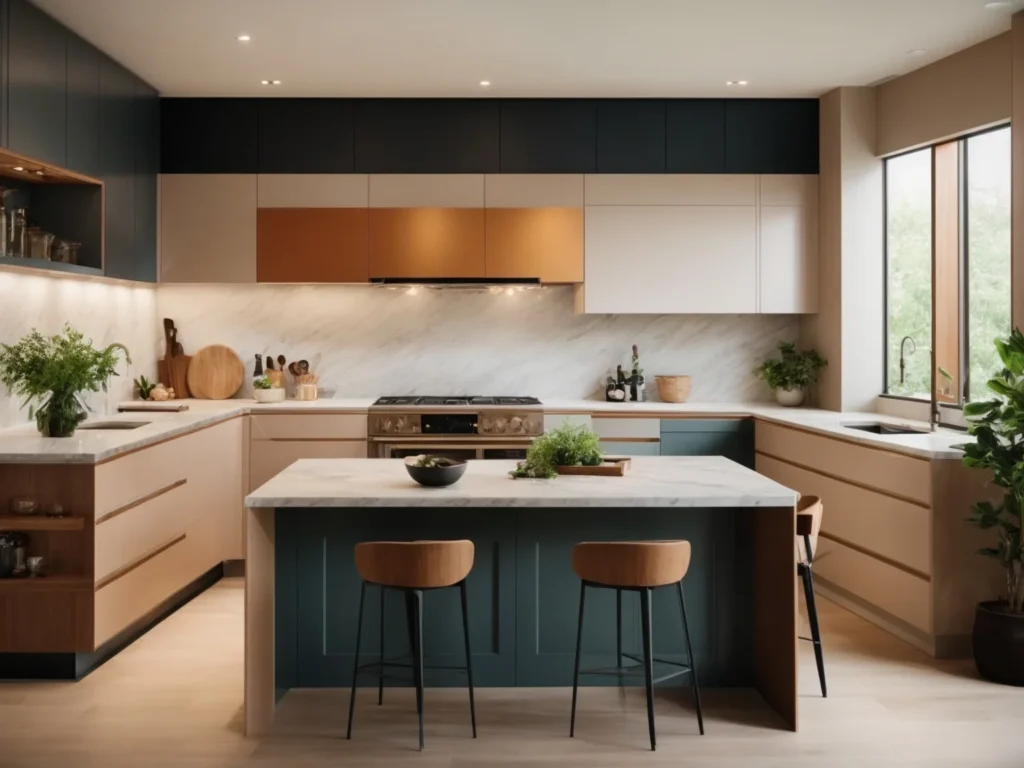
When choosing two cabinet colors, consider how they will look under both natural and artificial lighting. Some tones can appear dramatically different in different lighting, which can make the kitchen look disjointed. Test samples at home first.
Classic Combos

Some two-tone combinations have proven themselves over time as polished and stylish – white uppers and navy lowers, antique white uppers and charcoal lowers, light oak lowers with painted cream uppers. Feel free to start with a classic combo.
All Tones Work
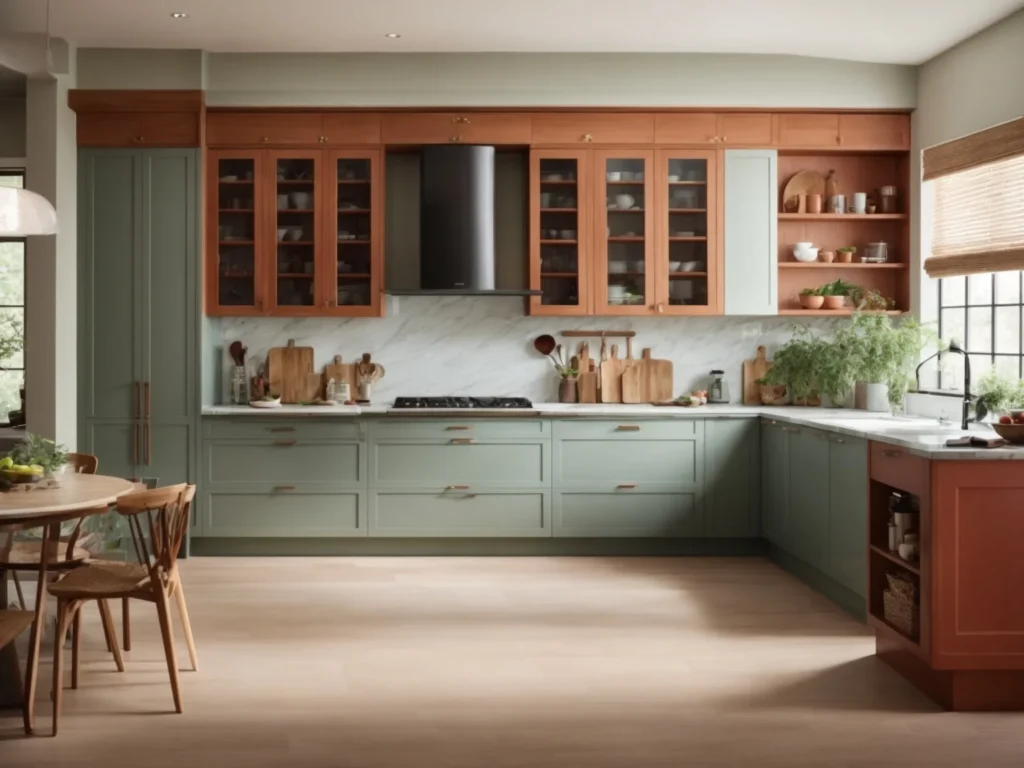
Every color family can work for two-tone cabinets. Even all-white kitchens can get in on the trend with glossy uppers and matte lowers. Don’t be afraid to get creative with unexpected colors like sage green, robin’s egg blue or brick red.
Tone and Texture
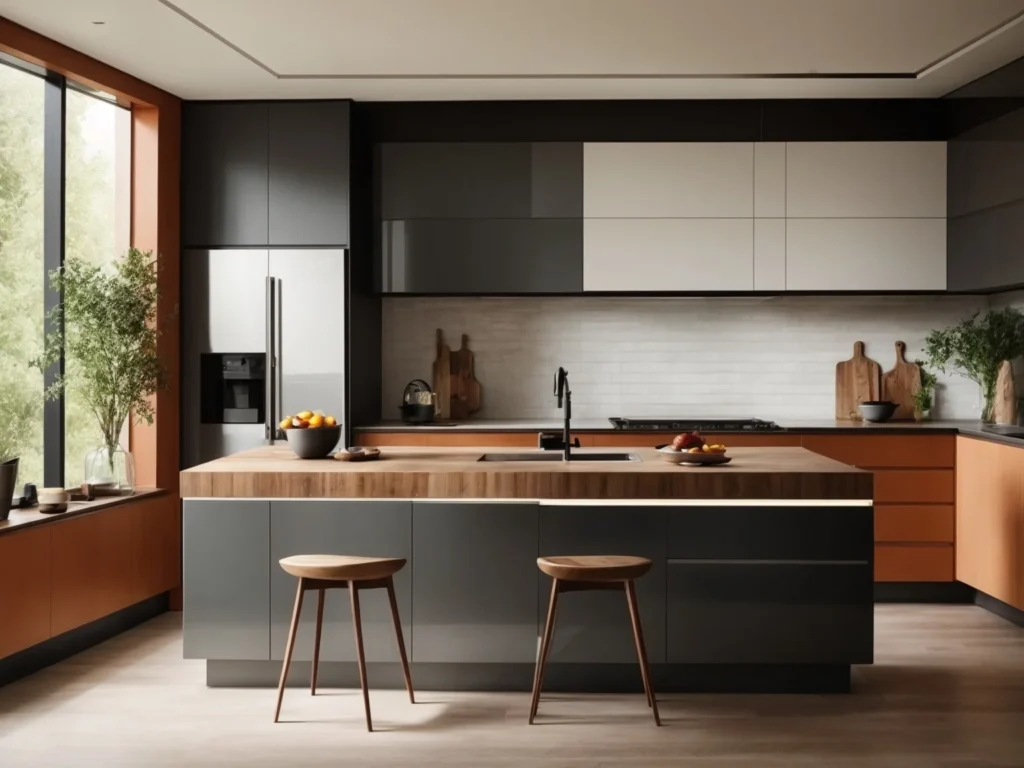
Glossy, smooth cabinet finishes pair best with matte, textured finishes for maximum contrast and visual dynamics. Wood grain lower cabinets are beautiful contrasted with sleek, painted uppers. Or, rough concrete-finish lowers with crisp gloss uppers.
Consistent Door Styles

Keep the same cabinet door style between the uppers and lowers. Mixing ornate lower doors with plain slab uppers can feel disjointed. Keeping the door format consistent ties the look together.
All Built-In Appliances
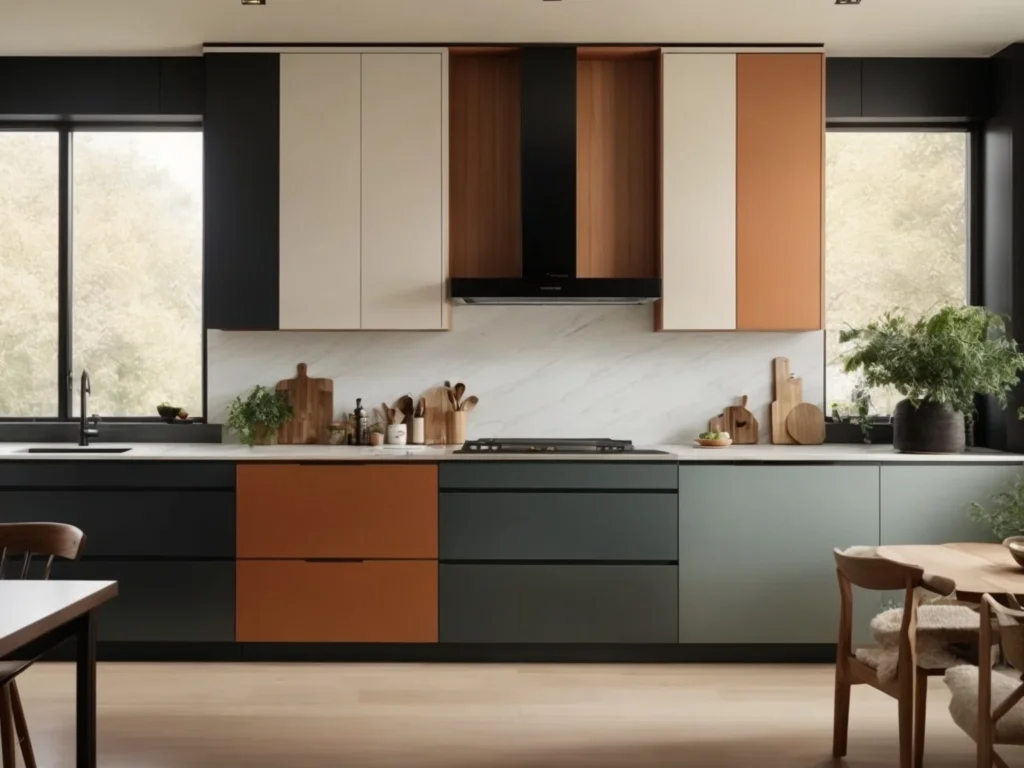
Mismatching appliance finishes can make the two-tone look feel choppy. Opt for appliances like refrigerators, ovens and dishwashers that can be built-in and fronted with cabinet panels for the most streamlined look.
Two-Tone Styles
Two-tone kitchen cabinets give homeowners so many possibilities to put their own creative spin on this trendy look:
Classic and Timeless

For a polished, timeless look, pair crisp white uppers with rich navy, charcoal or black lower cabinets. Then, choose brass accents and hardware for an iconic, traditional style that always looks fresh.
Retro Revival

Vintage kitchens are having a moment. For ‘50s flair, opt for robin’s egg blue lower cabinets with bright white uppers. Retro pink lower cabinets also pop against clean white uppers and chrome hardware.
Country Charm
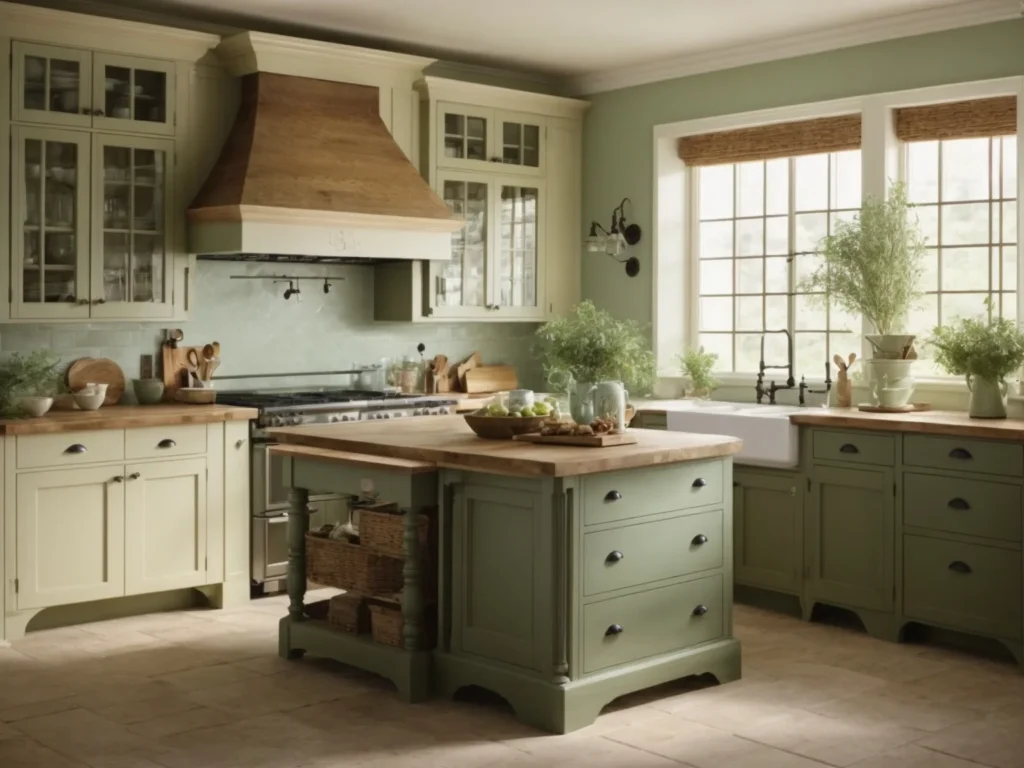
In country style kitchens, try weathered wood lowers with chippy, antique white uppers for a charming cottage look. For a bit of whimsy, painted sage green or brick red lower cabinets contrast beautifully with neutral uppers.
Contemporary Cool

Modern kitchens can gain dimension with two-tone cabinets as well. Glossy gray lower cabinets make a sleek statement against textured white uppers. Or, go for an ultra-modern vibe with walnut wood lowers and glossy white uppers.
Rustic Warmth
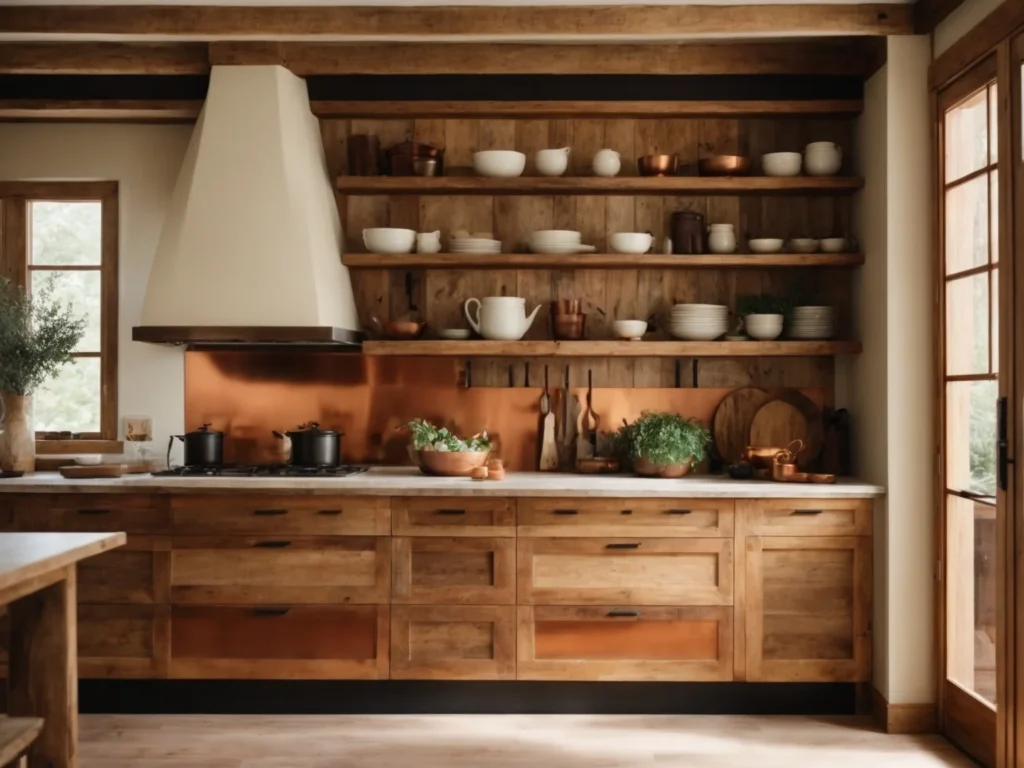
Play up the rustic aesthetic with natural wood stained lower cabinets and soft cream or muted sage green uppers. Also, try open shelving up top for an airy, farmhouse look. Copper accents warm up the space.
Industrial Edge
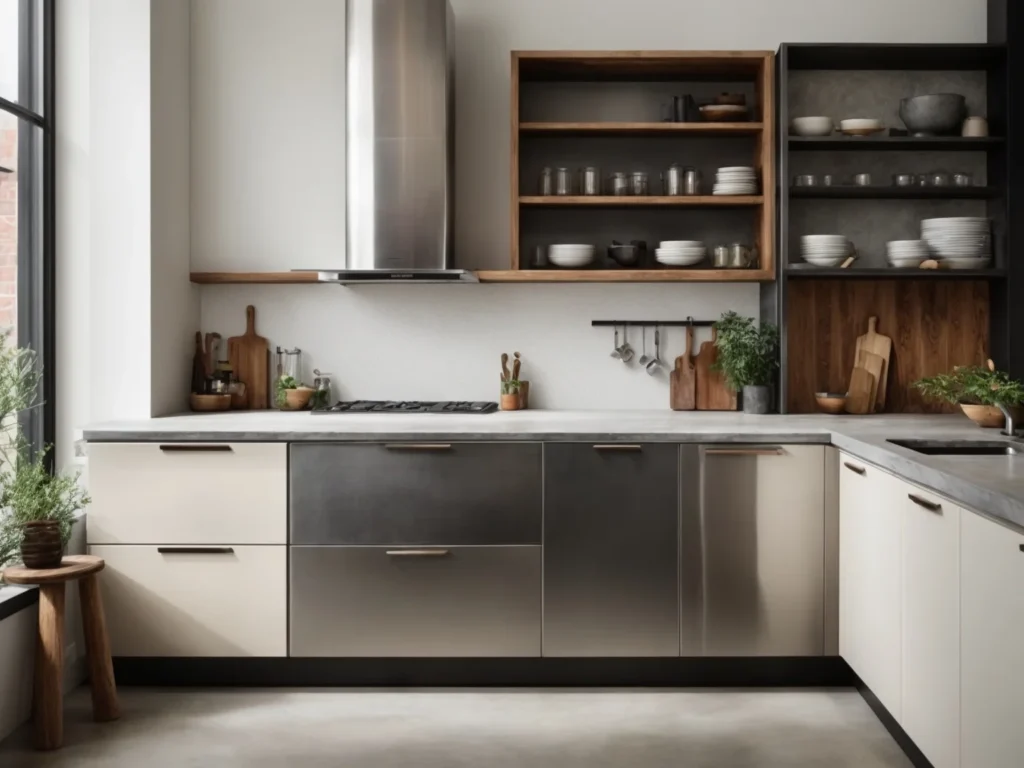
The industrial trend sees polished concrete-look lower cabinets paired with simple white uppers and open shelving for an edgy, urban warehouse aesthetic. Stainless steel hardware pushes the sleek, machined look even further.
Eclectic Mix
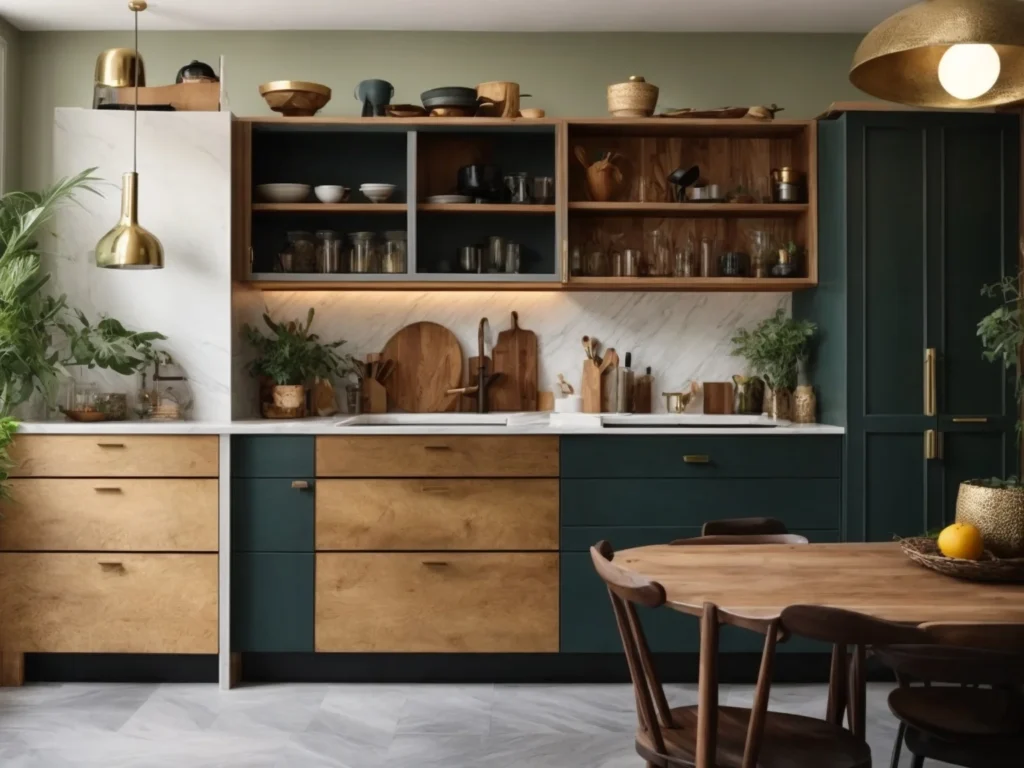
For the maximalists and adventurous, combine color, texture, and finish for an eclectic mismatched look. Try rough wood lower cabinets, glossy chalkboard uppers and brass hardware. Anything goes so have fun with this look!
Upper Cabinet Considerations
With so many aesthetic possibilities, selecting the perfect upper cabinet color and finish can make or break the kitchen’s style. Here are some factors to consider:
Light and Bright
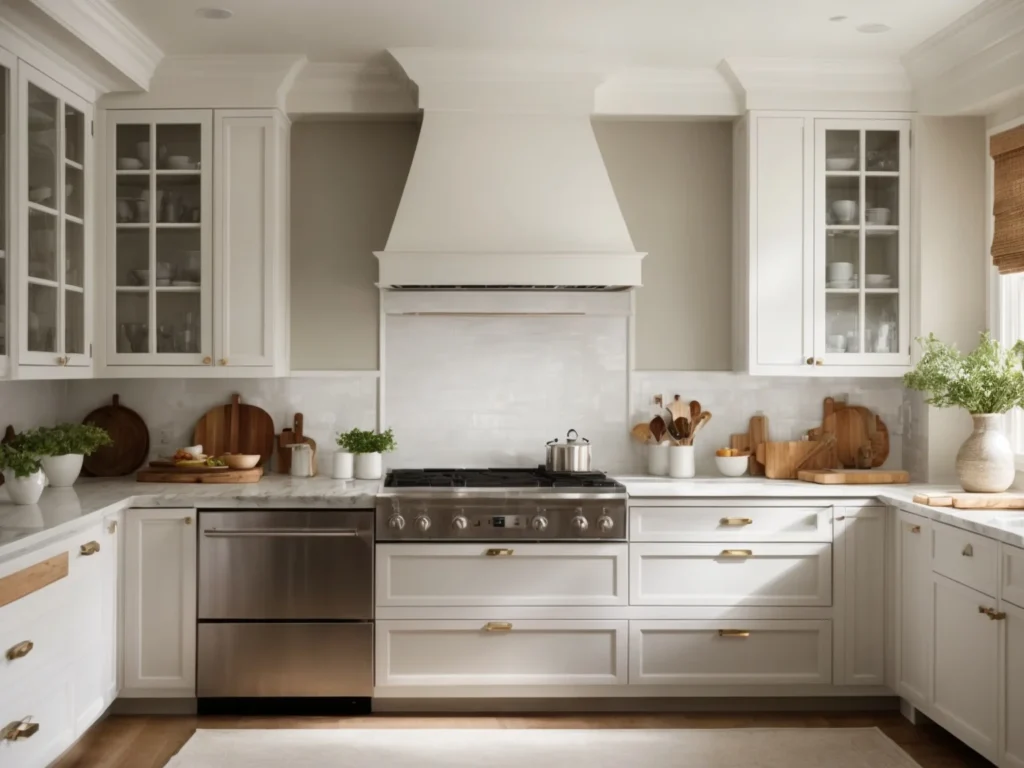
As mentioned, lighter upper cabinets open up smaller kitchens and add an airier feel. Crisp whites, soft grays, warm antique whites and light wood finishes are great versatile options. Paint color can also be customized.
Practicality
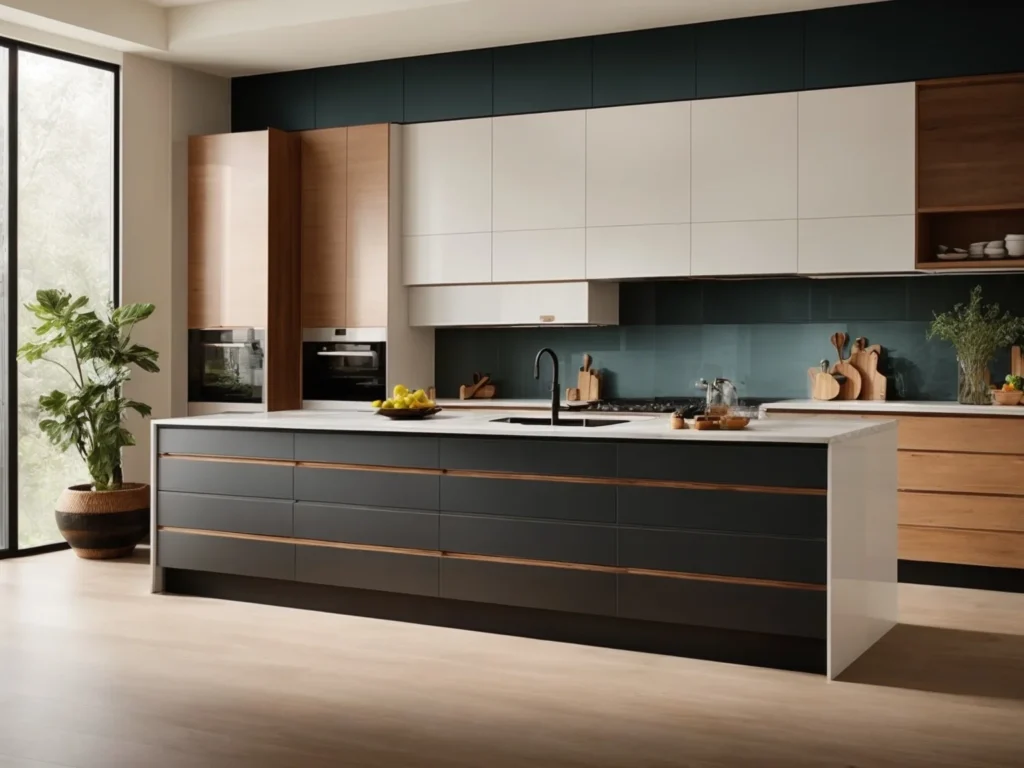
Consider how the upper cabinet finish will show dirt, grease, water spots and wear over time. Glossy uppers add style but show every fingerprint. Textured finishes like wood grain hide wear better. Also opt for durable cabinet materials.
Glass Fronts
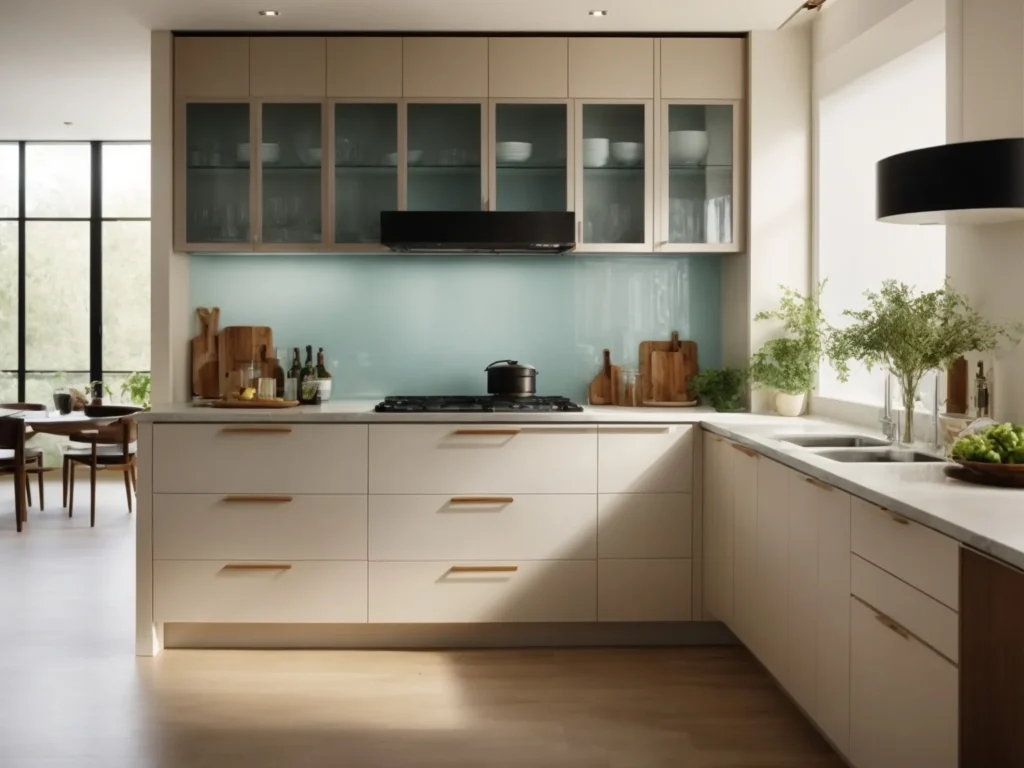
Glass-front upper cabinets maintain that light, open look while protecting interior contents from dust. For a lighter look, try etched glass fronts vs. heavily frosted glass. Just avoid heavy dishware that can rattle against the glass.
Open Shelving
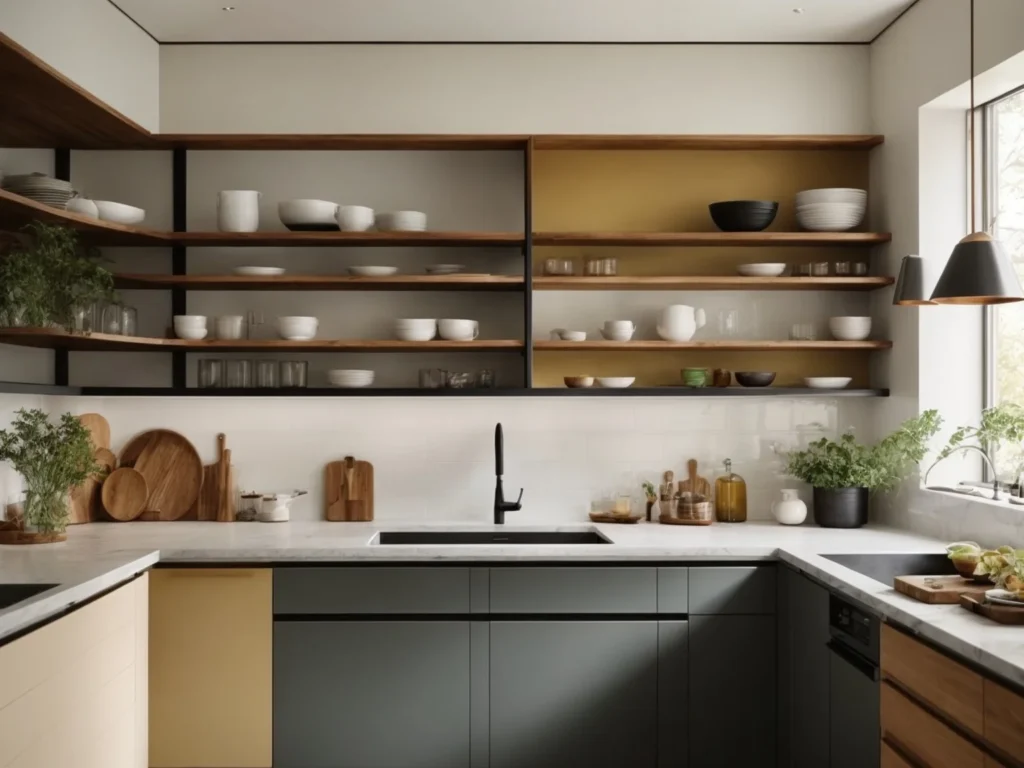
Floating open shelves are a lighter alternative to upper cabinets. They maintain visibility and access to items. Just be sure to use shelves for decorative items vs. frequently used dishes to keep dusting manageable.
Stylistic Contrast

Typically upper cabinets look best in lighter matte finishes that contrast with lower cabinets. Heavier tones or finishes on top can feel visually overwhelming. Make sure the uppers provide pleasing contrast.
Harmony With Backsplash
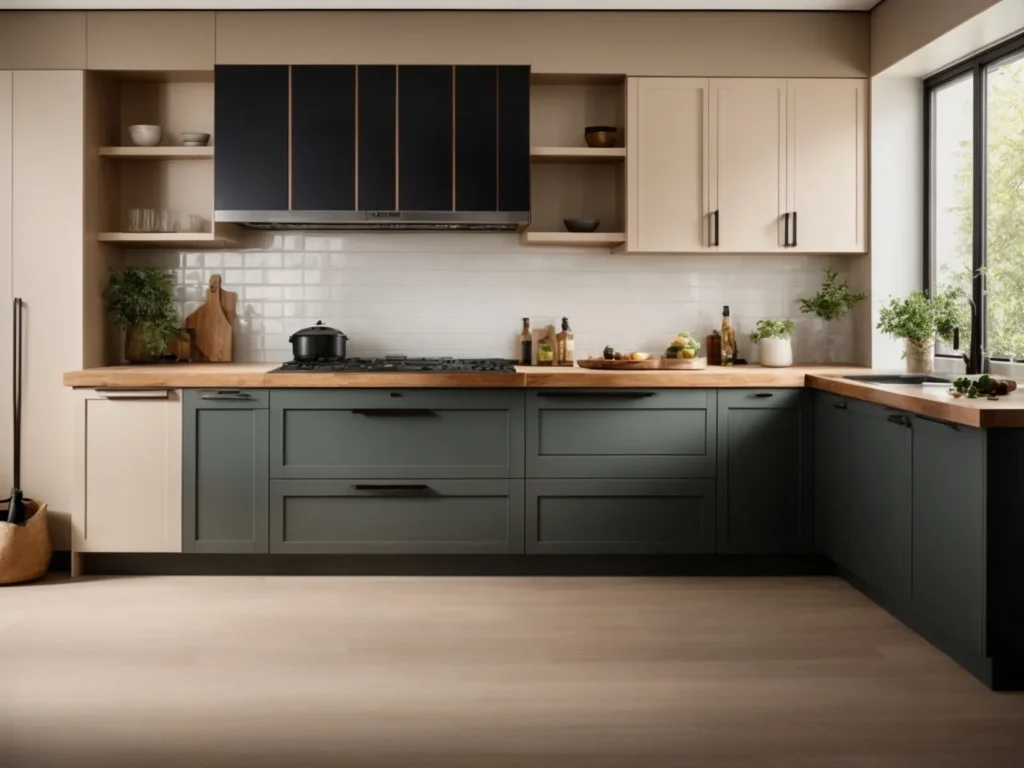
Consider how the upper cabinet tone relates to the kitchen backsplash. Contrasting finishes can feel disjointed. Try to select an upper cabinet color that ties in nicely with the backsplash tile colors and textures.
Reflection of Light

Lighter upper cabinet colors reflect light well in the kitchen whereas dark moody hues can absorb light and make the space feel dark. Factor in the effect of the upper color on light reflection.
Future Flexibility
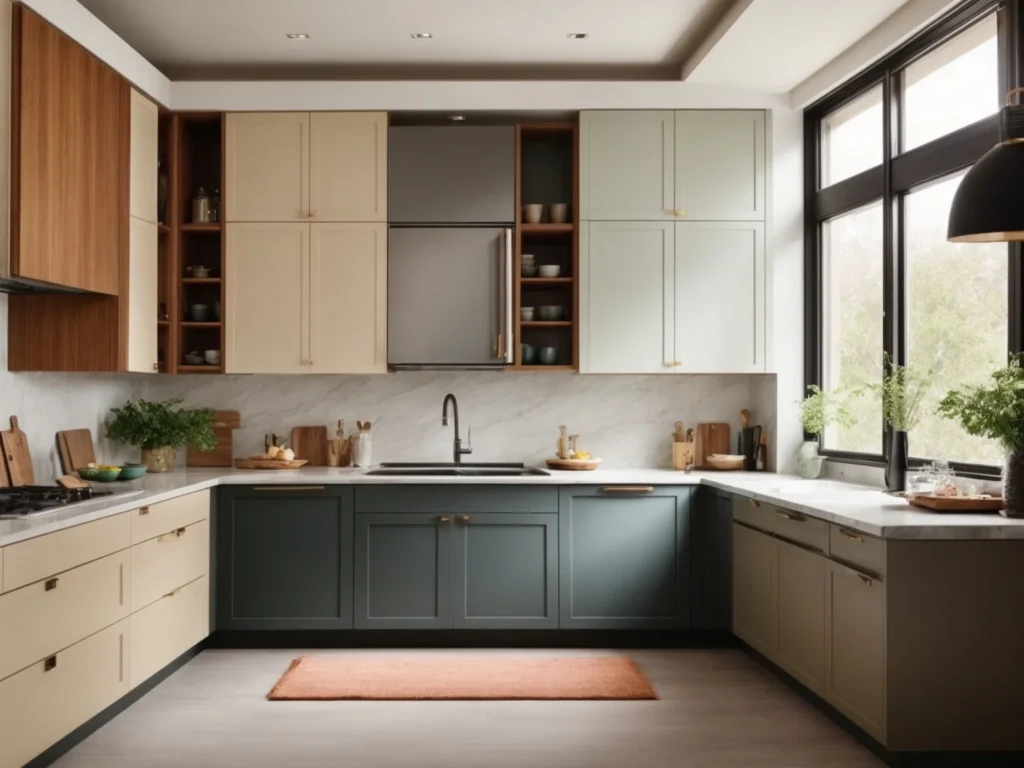
Upper cabinets are easier to repaint down the road. Opt for versatile, light neutrals or whites up top for flexibility. Pops of color can go on the lower cabinets which won’t need updating as frequently.
Lower Cabinet Considerations
Since they anchor the space, the lower cabinet selection is critical in establishing the kitchen’s aesthetic:
Materials
Durable hardwoods like oak and maple make beautiful lower cabinets that highlight craftsmanship. Thermally-fused laminate and wood laminate are budget-friendly options. Opt for water and scratch resistant materials.
Stains vs. Paints
Rich wood stains in oak, cherry or walnut exude warmth and often pair well with painted uppers. Custom stain colors are an option too. For color, painted lowers are easy to swap out down the road.
Door Styles
Slab cabinet doors, shaker style, inset panels and recessed panels all work beautifully in kitchens. Keep doors consistent with uppers but complementary to the uppers in color and finish.
Matte Finish
Typically a more matte, subtle finish on lower cabinets looks best, allowing the upper cabinets to shine. Glossy lower cabinets appear overwhelming. Soft matte paints or wood stains are prime choices.
Pulls and Handles
The lower cabinets present an opportunity to add unique hardware full of character. Try vintage glass knobs, handsome wrought iron pulls, or hammered copper handles to tie in accent metals from fixtures.
Toekicks
Toekicks receive a lot of abuse. Using a matching wood stain or durable painted finish ensures they don’t show wear over time. Large toekicks also proportionately balance out bold lower cabinets.
Contrast With Flooring
Make sure lower cabinet colors contrast adequately with the kitchen’s flooring. Too similar of tones can make cabinets appear to recede into the floor. The lower cabinets should stand out from the floor.
Stylistic Consistency
Keep the door style and finish consistent across all the lower cabinets for a polished, designer look. Mismatched colors or finishes from one set of lowers to another appears haphazard rather than intentional.
Work Triangles
Anchor key kitchen work triangles like sink-stove-refrigerator with lower cabinets in one consistent tone so there is visual flow between the critical zones. Break up secondary spaces with different colors.
Color Combination Ideas
When undertaking a two-tone kitchen, choosing the right color pairing is key to achieving the desired look and spatial effects. Here are some of the most popular and visually striking combinations:
Top and Bottom Color Variations

While some opt to paint upper and lower cabinets the same tone, others use two distinct colors to make each section pop. Lower cabinets tend to be bolder as they ground the space, while uppers can be more airy. Neutrals like white, gray and beige are common upper choices, paired with nearly any deep, vivid lower hue. For a contemporary vibe, bold lower cabinets in a sleek black, navy or charcoal anchor the space, contrasting crisp white uppers. Traditional kitchens may couple creamy uppers with rich wooden stains below. The options are truly endless when color blocking kitchen cabinets.
Specific Color Pairings
Let’s explore some of the most eye-catching two-tone color combinations for kitchen cabinets:
Two-Tone Kitchen Cabinets Brown and White
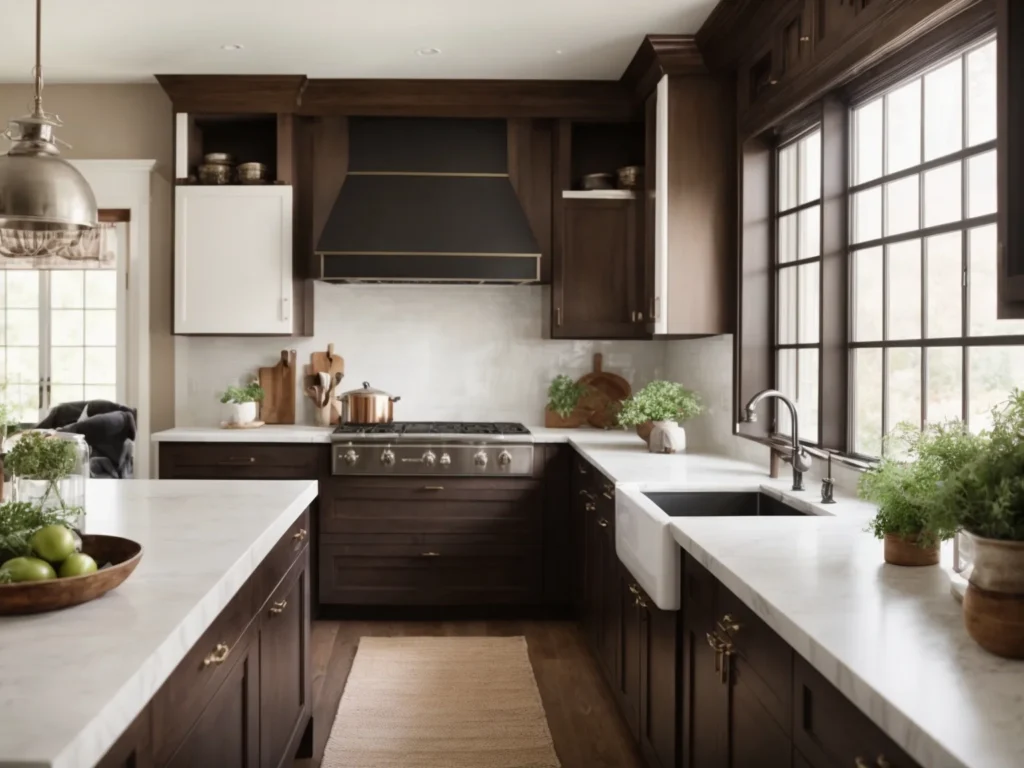
The timeless combination of cocoa brown lower cabinets with bright white uppers creates a look that suits any style of kitchen. Visually, the brown grounding anchors the cabinets while the white draws gaze upward, creating an airy, open look. This versatile neutral scheme works equally well in modern, farmhouse or traditional spaces. For a bit of contrast, dark charcoal lowers provide a sophisticated alternative to brown.
Two Tone Kitchen Cabinets Green and White
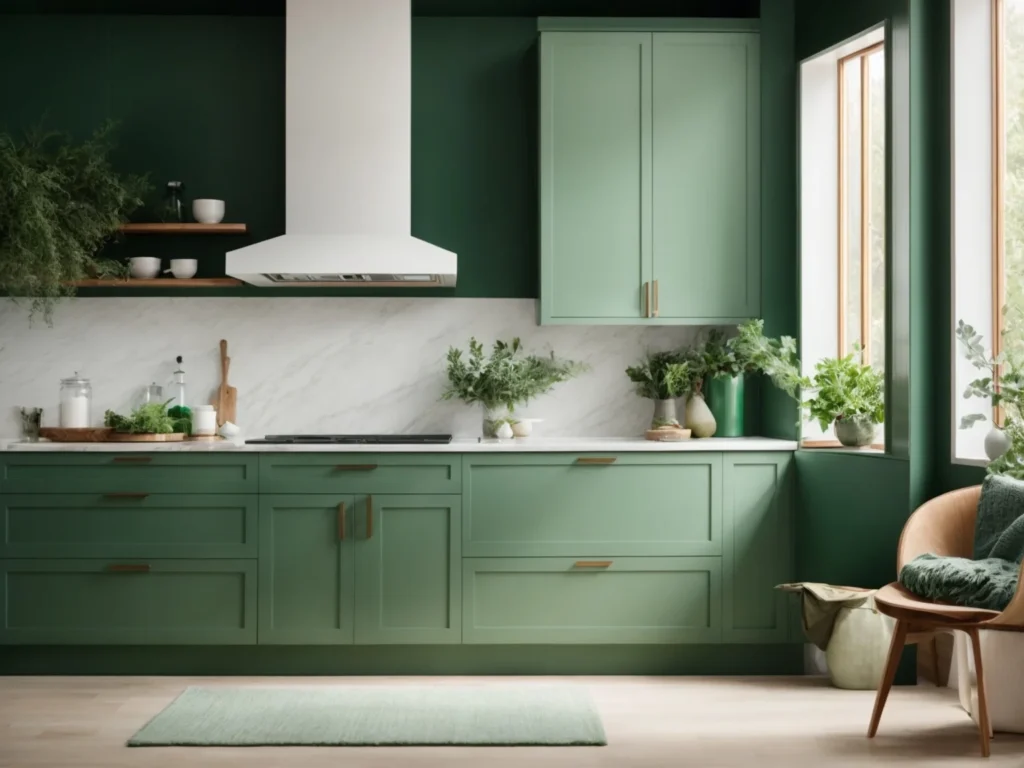
For a fresh, nature-inspired vibe, pairing vivid green lower cabinets with crisp white uppers brings life to the kitchen. The cool green recedes, making the space feel more expansive. A sage green creates a peaceful mood, while bolder emerald tones energize. Pair these impactful green bases with not just white, but also light blues, grays or beiges.
Two Tone Kitchen Cabinets Blue and White
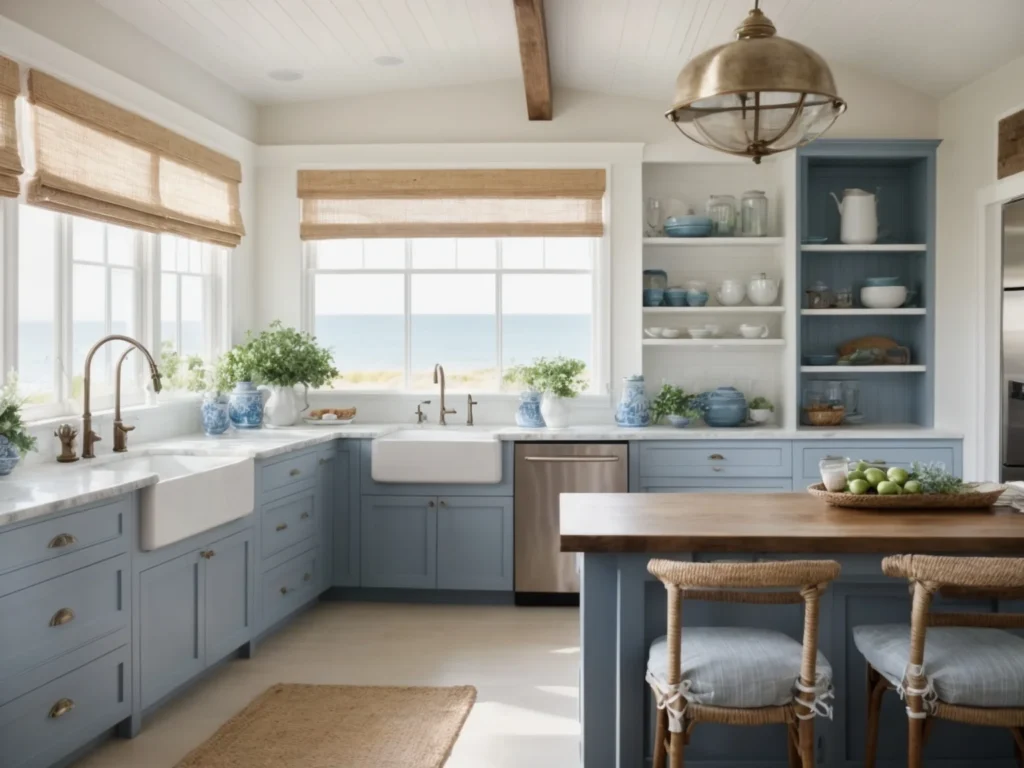
The timeless pairing of coastal blue and white evokes breezy, beach house vibes. Soft sky blue lower cabinets keep the mood airy and ethereal. For a bolder nautical statement, try navy below. Crisp whites above provide balance while giving the illusion of higher ceilings. This versatile combination suits coastal, farmhouse or contemporary spaces equally.
Two-Tone Kitchen Cabinets Grey and White

For an on-trend modern kitchen, charcoal or gray lower cabinets coupled with bright white uppers creates a sophisticated, sleek look. The neutral scheme is endlessly flexible, suiting any style. Pair with chrome fixtures and granite counters for contemporary flair or wooden accents for farmhouse charm. The gray grounds the space while the white opens it up.
Design Considerations for Small Kitchens
Two-tone cabinets can help a small kitchen feel more spacious, but color choice and placement are key. Here are some tips for designing a two-tone kitchen to enlarge a smaller room:
- Use light, cool colors like blue, green or gray on lower cabinets to recede boundaries back.
- Select lighter, airy tones like white, beige or light gray for upper cabinets to draw gaze up.
- Add mirrors and reflective surfaces to open up space.
- Incorporate glass cabinet doors to maintain visibility and flow.
- Keep countertops light to prevent a closed-in feeling.
- Use a gloss or semi-gloss finish to reflect light around.
- Install undercabinet lighting to brighten and open up space.
With thoughtful color and design selections, two-tone cabinets can make a small kitchen feel expansive and beautiful.
Trend Analysis and Future Predictions
Two-tone cabinets have been rising in popularity over the past decade, but how much staying power does this trend really have? Here’s an analysis of where the style has been, and predictions for where it’s heading:
Are 2 Tone Kitchen Cabinets in Style 2024?
Two-tone kitchen cabinets show no signs of going out of style any time soon. The eclectic, mix-and-match aesthetic suits the growing desire for personalized, unique spaces over one-size-fits-all designs. With so many potential color combinations, two-tone allows limitless possibilities to put a creative spin on kitchen cabinets. The dimensional contrast and spatial effects created by smart color blocking make this trend an endlessly flexible one. Two-tone cabinets have appeal across styles from modern to traditional to rustic farmhouse. Their popularity has steadily risen over the past decade and is expected to continue growing into 2024 and beyond.
Are 2 Toned Kitchen Cabinets Too Trendy?
A common concern with any bold trend is longevity – no one wants to invest in an overly trendy look that will appear quickly dated. The key benefit of two-tone kitchen cabinets is their flexibility and ability to suit any style kitchen. By keeping the color scheme and placement strategic based on the needs of the space, any combination can be made timeless. Sticking with versatile, classic color pairings avoids an overly “trendy” look. Plus, cabinet paint colors can be easily adapted down the road for an updated look. As long as the two tones are selected thoughtfully, this design choice is built to last the years as an inviting, creative twist on kitchen cabinets.
Matching Cabinets with Countertops
When designing a two-tone kitchen, incorporating countertops into the mix requires careful coordination. Here are some tips on choosing countertop colors to complement your cabinets:
Should Cabinets Be Lighter or Darker Than Countertops?
There are pros and cons to both lighter and darker cabinet color choices versus countertops. Darker cabinets ground the space and make counters appear to pop. But darker cabinets show dust more readily. Lighter cabinets maintain an airy, open look and hide dirt better. But light cabinets can get lost against busy countertops.
Ultimately the choice comes down to personal preference and the desired look. For contemporary spaces, white or gray cabinets provide an airy contrast against dramatic dark stone or quartz counters. In traditional kitchens, deeper wooden cabinet stains coordinate well with lighter marble or granite counters. There is no right or wrong choice – just make sure to view all materials together before installation to ensure your desired contrast and flow.
Two-Tone Cabinets with Kitchen Islands

Kitchen islands present another opportunity to incorporate two tones in a harmonious way. A popular approach is using the main kitchen cabinet colors on the island as well. For example, white uppers and blue lowers on the perimeter matched on the island. This creates a cohesive, uniform look. However, the island can also be a chance to introduce a third color for added flair. A navy and white kitchen could feature a green or butcher block island for contrast. Just be wary of adding too many competing colors in a small space. For a more coordinated vibe, the island cabinets can match either the uppers or lowers of the main kitchen run.
Conclusion
Two-tone kitchen cabinets open up a world of possibilities to add striking visual contrast, alter perceptions of space, and totally transform the vibe of your kitchen. The strategic combination of colors and placement create dimension and interest, while suiting any style from sleek modern to homey traditional. While once a daring trend, two-toned kitchens have proven their lasting power and flexibility. With so many potential color pairings, this look can be tailored to any taste. Keeping cabinet colors coordinated with counters and other finishes creates a harmonious, holistic kitchen design. Maximize smaller spaces with light, airy uppers and ground larger kitchens with rich, deep hues below. However you choose to implement it, embracing the two-tone cabinet trend is a savvy way to upgrade your kitchen with creativity and style.
